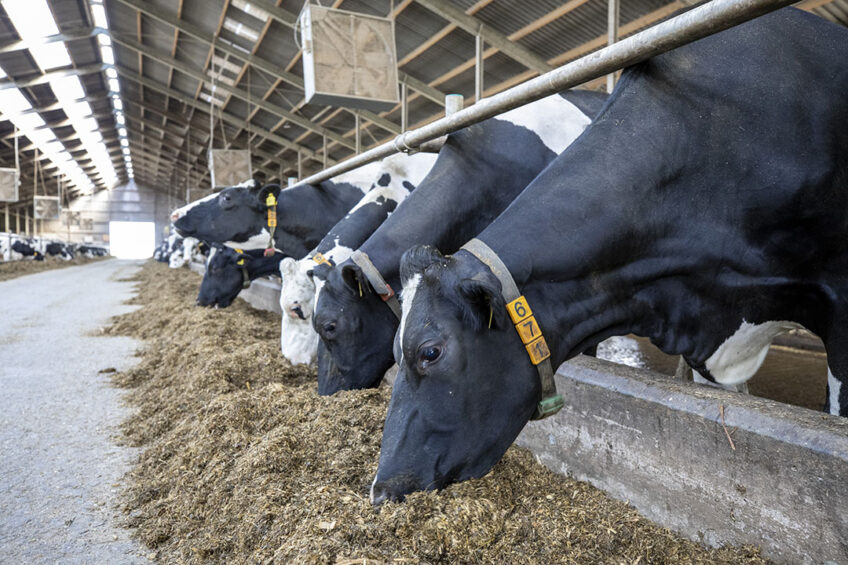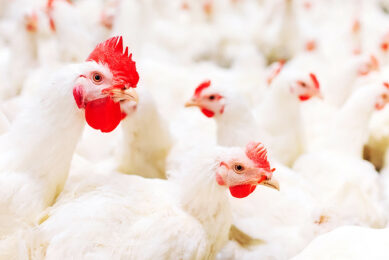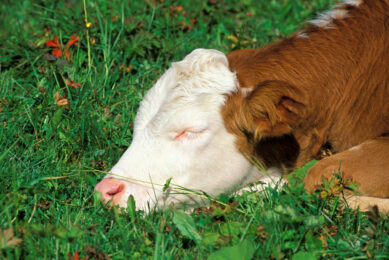Benefits of biosynthetic bacterial 6-phytase in dairy cows

A recent study published in the Journal of Animal Science demonstrates how the addition of exogenous phytase of at least 2,000 FTU/kg to diets of lactating dairy cows improves the digestibility of phosphorus, calcium and protein while reducing the faecal excretion of these nutrients.
Several studies show that ruminant livestock production accounts for up to approximately 70% of the phosphorus (P) waste produced by farmed animals. In dairy farming, this waste arises mostly from the excretion of undigested P in faeces. Optimising dietary P content so that P is fed closer to requirement levels and improving P utilisation from the feed are key strategies for reducing P excretion. Achieving this could cut feed costs by reducing the need to add costly inorganic sources of phosphate. This also increases the sustainability of dairy production, while allowing more flexibility in the choice of ingredients that contain P. In plant-based feed ingredients, the majority of P is present in the form of phytate, which must be broken down to release inorganic phosphate that can directly be used for growth and maintenance.
Why use phytase in dairy diets?
For a long time it has been believed that phytase supplementation in dairy cattle diets is not necessary due to the substantial phytase activity of ruminal bacteria that hydrolyse phytate, releasing inorganic phosphorus that is later absorbed in the small intestine. However, more recent studies have reported lower and more variable estimates of apparent total tract digestibility (ATTD) of phytate-P (PP) of between 69% and 97%. Phytate degradability in the rumen may vary depending on the composition of the diet and forage-to-concentrate ratio that may alter the ruminal microflora and hence their capacity to digest phytate. The ruminal P availability of individual ingredients may be influenced by processing methods designed to protect proteins from ruminal degradation, and the faster flow rate of the digesta of modern high producing cows fed easily fermentable carbohydrates may result in some PP leaving the rumen undegraded. Furthermore, the neutral pH of the rumen, which is typically pH 6.0 to 7.0, may not be optimal for ruminal microbes producing cysteine phytases, which are most active at pH 4.5.
The study
The current study investigated the addition of a biosynthetic bacterial 6-phytase to diets of lactating dairy cows with no added inorganic phosphorus (Pi) and its effect on the digestibility and utilisation of total phosphorus (P), phytate-P (PP), and crude protein (CP). The experiment was carried out with 30 Holstein-Friesian dairy cows. Treatment diets comprised of a control diet formulated without supplemental Pi and 2 experimental diets based on the control diet but supplemented with a commercial phytase at a targeted dose level of 2,000 or 5,000 (PhyG2,000 or PhyG5,000) phytase units (FTU) per kilogramme of the total ration on a dry matter (DM) basis. The phytase was a biosynthetic bacterial 6-phytase (PhyG) (Danisco Animal Nutrition and Health, IFF Inc., the Netherlands), expressed in Trichoderma reesei.
Milk yield and composition
Results showed no effect of the phytase on milk production or the fat and lactose contents of milk. However, cows fed PhyG5,000 tended to have a higher milk protein content than cows fed the control diet. The observed tendency towards a higher content of milk protein in the highest phytase dose treatment compared to the control was consistent with the increased CP digestibility and suggested there was a higher availability of protein in the PhyG5,000 diet due to the activity of the phytase.
Phosphorus and calcium digestibility
Regarding P digestibility, there was a linear increase in ATTD of P when increasing the phytase dose that resulted in an improvement of 8% points above control when the phytase was dosed at 5,000 FTU/kg DM. On the other hand, phytase dosed at a higher level (5,000 FTU/kg DM) also improved the ATTD of calcium (Ca). In monogastric animals, a positive effect of phytase on Ca digestibility has been attributed to a reduction in the formation of Ca-phytate complexes in the GIT because of the degradation of phytate. The researchers had this to say: “As the specific gut regions of activity of PhyG in the dairy cow GIT have yet to be elucidated, it is unclear whether a similar mode of action could have led to the increased Ca digestibility in cows fed PhyG5,000, or alternatively whether it was linked to improved P digestibility and therefore a better balance of Ca to P at the sites of absorption, leading to greater absorption of Ca.”
Phytate-P digestibility
This study also showed a clear effect of phytase supplementation on the ATTD of Phytate-P (PP). The ATTD of PP in the control group (93%) was considerably below the 98% observed in the early study; suggesting, contrary to past beliefs, that the PP of feeds may not be fully utilised by dairy cows. “This may be particularly the case when phytate-rich and rumen-protected ingredients are included. It is in such diets that exogenous phytase could have the most benefit,” they said. In the current study, cows exhibited ATTD of PP increases (above control) of 2.5% and 4.6% points with PhyG dosed at 1,813 and 6,403 FTU/kg DM, respectively (based on analysed phytase activity). “Clearly, the physiological stage of the dairy cows, the dietary composition, basal PP digestibility level and phytase source could all impact the effect of exogenous phytase on ATTD of PP,” they concluded.
Crude protein digestibility
The hydrolysis of phytate by microbial phytase has been shown consistently in studies of monogastric animals to have a direct improvement effect on P availability and digestibility but it can also indirectly improve the availability and digestibility of other nutrients that are associated with phytate in the digesta. In the current study, cows fed the PhyG5,000 diet exhibited a clear increase in ATTD of crude protein (CP). The ATTD of CP was improved by approximately 3% points and 4% points with the lowest dose of phytase (2,000 FTU/kg DM) and 5,000 FTU/kg DM, respectively. However, it was commented that the mode of action of phytase in improving either the amino acid or CP digestibility in dairy cows is unclear.
Conclusion
This study has clearly shown that supplementation of the novel phytase at a dose level of 2,000 FTU/kg or higher to dairy cow diets offers potential as an approach for reducing faecal excretion of P and CP by improving their digestibility in the diet. In this way, phytase supplementation offers an important approach to optimising nutrient balance and reducing environmental P and N pollution from dairy farms. The researchers recommended further studies under long-term conditions with early lactating dairy cows.
The article is based on an original article by Yueming Dersjant-Li, Ivonne Kok, Edwin Westreicher-Kristen, Rubén García-González, Alessandro Mereu, Trine Christensen, and Leon Marchal. 2023. Effect of a biosynthetic bacterial 6-phytase on the digestibility of phosphorus and phytate in mid-lactating dairy cows. Journal of Animal Science, 101: 1–12.











